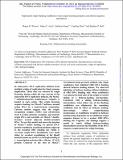Replication origin–flanking roadblocks reveal origin-licensing dynamics and altered sequence dependence
Author(s)
Warner, Megan Dobbins; Azmi, Ishara F; Kang, Sukhyun; Bell, Stephen P
DownloadAccepted version (9.957Mb)
Terms of use
Metadata
Show full item recordAbstract
In eukaryotes, DNA replication initiates from multiple origins of replication for timely genome duplication. These sites are selected by origin licensing, during which the core enzyme of the eukaryotic DNA replicative helicase, the Mcm2-7 (minichromosome maintenance) complex, is loaded at each origin. This origin licensing requires loading two Mcm2-7 helicases around origin DNA in a head-to-head orientation. Current models suggest that the origin-recognition complex (ORC) and cell-division cycle 6 (Cdc6) proteins recognize and encircle origin DNA and assemble an Mcm2-7 double-hexamer around adjacent double-stranded DNA. To test this model and assess the location of Mcm2-7 initial loading, we placed DNA-protein roadblocks at defined positions adjacent to the essential ORC-binding site within Saccharomyces cerevisiae origin DNA. Roadblocks were made either by covalent cross-linking of the HpaII methyltransferase to DNA or through binding of a transcription activator-like effector (TALE) protein. Contrary to the sites of Mcm2-7 recruitment being precisely defined, only single roadblocks that inhibited ORC-DNA binding showed helicase loading defects. We observed inhibition of helicase loading without inhibition of ORC-DNA binding only when roadblocks were placed on both sides of the origin to restrict sliding of a helicase-loading intermediate. Consistent with a sliding helicase-loading intermediate, when either one of the flanking roadblocks was eliminated, the remaining roadblock had no effect on helicase loading. Interestingly, either origin-flanking nucleosomes or roadblocks resulted in helicase loading being dependent on an additional origin sequence known to be a weaker ORC-DNA-binding site. Together, our findings support a model in which sliding helicase-loading intermediates increase the flexibility of the DNA sequence requirements for origin licensing.
Date issued
2017-10Department
Massachusetts Institute of Technology. Department of BiologyJournal
Journal of biological chemistry
Publisher
American Society for Biochemistry & Molecular Biology (ASBMB)
Citation
Warner, Megan D. et al. “Replication origin–flanking roadblocks reveal origin-licensing dynamics and altered sequence dependence.” Journal of biological chemistry, vol. 292, no. 52, 2017, pp. 21417-21430 © 2017 The Author(s)
Version: Author's final manuscript
ISSN
0021-9258